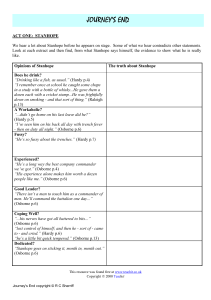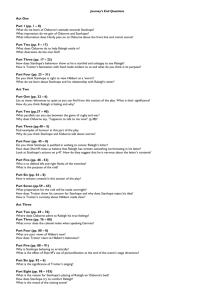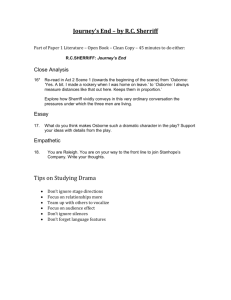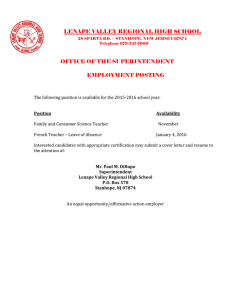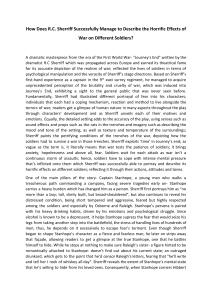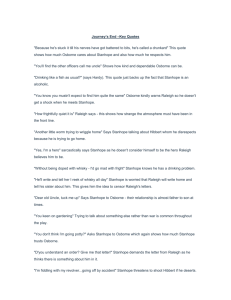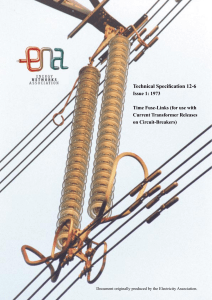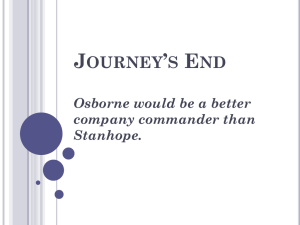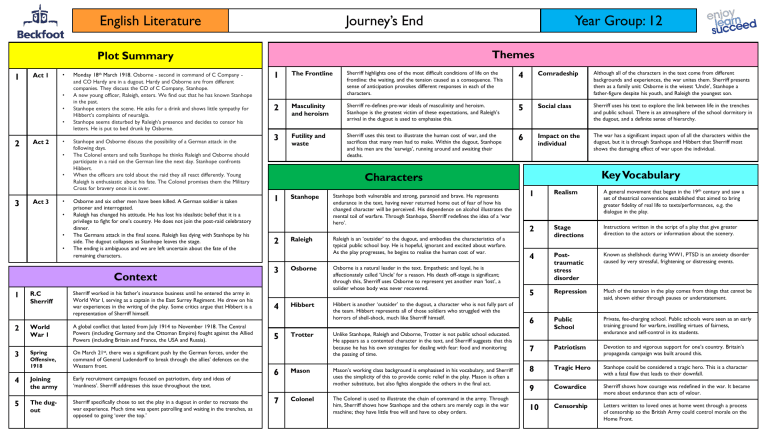
English Literature Journey’s End Themes Plot Summary 1 Act 1 • • • • 2 Act 2 • • • 3 Act 3 • • • • Monday 18th March 1918. Osborne - second in command of C Company and CO Hardy are in a dugout. Hardy and Osborne are from different companies. They discuss the CO of C Company, Stanhope. A new young officer, Raleigh, enters. We find out that he has known Stanhope in the past. Stanhope enters the scene. He asks for a drink and shows little sympathy for Hibbert’s complaints of neuralgia. Stanhope seems disturbed by Raleigh’s presence and decides to censor his letters. He is put to bed drunk by Osborne. Stanhope and Osborne discuss the possibility of a German attack in the following days. The Colonel enters and tells Stanhope he thinks Raleigh and Osborne should participate in a raid on the German line the next day. Stanhope confronts Hibbert. When the officers are told about the raid they all react differently. Young Raleigh is enthusiastic about his fate. The Colonel promises them the Military Cross for bravery once it is over. Osborne and six other men have been killed. A German soldier is taken prisoner and interrogated. Raleigh has changed his attitude. He has lost his idealistic belief that it is a privilege to fight for one’s country. He does not join the post-raid celebratory dinner. The Germans attack in the final scene. Raleigh lies dying with Stanhope by his side. The dugout collapses as Stanhope leaves the stage. The ending is ambiguous and we are left uncertain about the fate of the remaining characters. Context R.C Sherriff Sherriff worked in his father’s insurance business until he entered the army in World War I, serving as a captain in the East Surrey Regiment. He drew on his war experiences in the writing of the play. Some critics argue that Hibbert is a representation of Sherriff himself. 2 World War 1 A global conflict that lasted from July 1914 to November 1918. The Central Powers (including Germany and the Ottoman Empire) fought against the Allied Powers (including Britain and France, the USA and Russia). 3 Spring Offensive, 1918 On March 21st, there was a significant push by the German forces, under the command of General Ludendorff to break through the allies’ defences on the Western front. 4 Joining the army Early recruitment campaigns focused on patriotism, duty and ideas of ‘manliness’. Sherriff addresses this issue throughout the text. 5 The dugout Sherriff specifically chose to set the play in a dugout in order to recreate the war experience. Much time was spent patrolling and waiting in the trenches, as opposed to going ‘over the top.’ 1 Year Group: 12 1 The Frontline Sherriff highlights one of the most difficult conditions of life on the frontline: the waiting, and the tension caused as a consequence. This sense of anticipation provokes different responses in each of the characters. 4 Comradeship Although all of the characters in the text come from different backgrounds and experiences, the war unites them. Sherriff presents them as a family unit: Osborne is the wisest ‘Uncle’, Stanhope a father-figure despite his youth, and Raleigh the youngest son. 2 Masculinity and heroism Sherriff re-defines pre-war ideals of masculinity and heroism. Stanhope is the greatest victim of these expectations, and Raleigh’s arrival in the dugout is used to emphasise this. 5 Social class Sherriff uses his text to explore the link between life in the trenches and public school. There is an atmosphere of the school dormitory in the dugout, and a definite sense of hierarchy. 3 Futility and waste Sherriff uses this text to illustrate the human cost of war, and the sacrifices that many men had to make. Within the dugout, Stanhope and his men are the ‘earwigs’, running around and awaiting their deaths. 6 Impact on the individual The war has a significant impact upon of all the characters within the dugout, but it is through Stanhope and Hibbert that Sherriff most shows the damaging effect of war upon the individual. Key Vocabulary Characters 1 2 3 4 5 6 7 Stanhope Raleigh Osborne Hibbert Trotter Mason Colonel Stanhope both vulnerable and strong, paranoid and brave. He represents endurance in the text, having never returned home out of fear of how his changed character will be perceived. His dependence on alcohol illustrates the mental toil of warfare. Through Stanhope, Sherriff redefines the idea of a ‘war hero’. Raleigh is an ‘outsider’ to the dugout, and embodies the characteristics of a typical public school boy. He is hopeful, ignorant and excited about warfare. As the play progresses, he begins to realise the human cost of war. Osborne is a natural leader in the text. Empathetic and loyal, he is affectionately called ‘Uncle’ for a reason. His death off-stage is significant; through this, Sherriff uses Osborne to represent yet another man ‘lost’, a solider whose body was never recovered. Hibbert is another ‘outsider’ to the dugout, a character who is not fully part of the team. Hibbert represents all of those soldiers who struggled with the horrors of shell-shock, much like Sherriff himself. Unlike Stanhope, Raleigh and Osborne, Trotter is not public school educated. He appears as a contented character in the text, and Sherriff suggests that this because he has his own strategies for dealing with fear: food and monitoring the passing of time. Mason’s working class background is emphasised in his vocabulary, and Sherriff uses the simplicity of this to provide comic relief in the play. Mason is often a mother substitute, but also fights alongside the others in the final act. The Colonel is used to illustrate the chain of command in the army. Through him, Sherriff shows how Stanhope and the others are merely cogs in the war machine; they have little free will and have to obey orders. 1 Realism A general movement that began in the 19th century and saw a set of theatrical conventions established that aimed to bring greater fidelity of real life to texts/performances, e.g. the dialogue in the play. 2 Stage directions Instructions written in the script of a play that give greater direction to the actors or information about the scenery. 4 Posttraumatic stress disorder Known as shellshock during WW1, PTSD is an anxiety disorder caused by very stressful, frightening or distressing events. 5 Repression Much of the tension in the play comes from things that cannot be said, shown either through pauses or understatement. 6 Public School Private, fee-charging school. Public schools were seen as an early training ground for warfare, instilling virtues of fairness, endurance and self-control in its students. 7 Patriotism Devotion to and vigorous support for one’s country. Britain’s propaganda campaign was built around this. 8 Tragic Hero Stanhope could be considered a tragic hero. This is a character with a fatal flaw that leads to their downfall. 9 Cowardice Sherriff shows how courage was redefined in the war. It became more about endurance than acts of valour. 10 Censorship Letters written to loved ones at home went through a process of censorship so the British Army could control morale on the Home Front.
